
Kanchanaburi is the largest of the western provinces (changwat) of Thailand. The neighboring provinces are Tak, Uthai Thani, Suphan Buri, Nakhon Pathom, and Ratchaburi. In the west it borders Kayin State, Mon State, and the Tanintharyi Region of Myanmar.

Uthai Thani, one of Thailand's seventy-six provinces (changwat) lies in lower northern Thailand. Neighbouring provinces are Nakhon Sawan, Chai Nat, Suphan Buri, Kanchanaburi and Tak. It lies somewhat off the route between Bangkok, 200 km distant and Chiang Mai.

The Thung Yai Naresuan Wildlife Sanctuary is a protected area in Thailand in the northern part of Kanchanaburi Province and the southern part of Tak Province. It was declared a wildlife sanctuary in 1972, and a World Heritage Site by UNESCO in 1991 together with the adjoining Huai Kha Khaeng Wildlife Sanctuary.
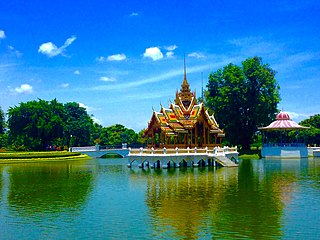
Bang Pa-in is one of the 16 districts (amphoe) of Phra Nakhon Si Ayutthaya province, central Thailand.

Sai Yok is a district (amphoe) in Kanchanaburi province in western Thailand.

Sangkhla Buri is a district (amphoe) in Kanchanaburi province in western Thailand.
Kuy, also known as Kui, Suay or Kuay, is a Katuic language, part of the larger Austroasiatic family spoken by the Kuy people of Southeast Asia.
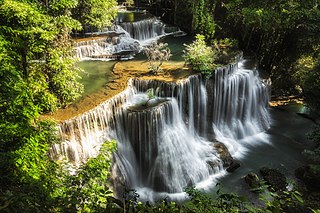
Si Sawat is a district (amphoe) in Kanchanaburi province, western Thailand.
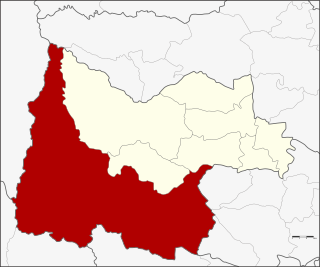
Ban Rai is a district (amphoe) in Uthai Thani province in western Thailand.

Mueang Kanchanaburi is the capital district of Kanchanaburi province, central Thailand.
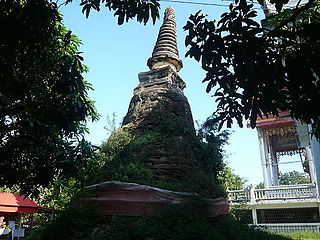
Phanom Thuan is a district (amphoe) in the eastern part of Kanchanaburi province, western central Thailand.

Bo Phloi is a district (amphoe) of Kanchanaburi province, central Thailand.

Lao Khwan is a district (amphoe) in the northeastern part of Kanchanaburi province, central Thailand.
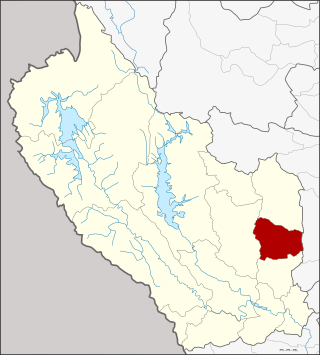
Huai Krachao is a district (amphoe) in the eastern part of Kanchanaburi province, central Thailand.
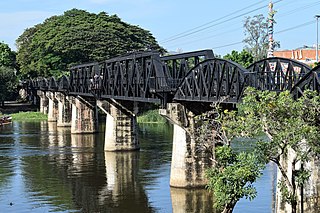
The Khwae Yai River, also known as the Si Sawat, is a river in western Thailand. It has its source in the Tenasserim Hills and flows for about 380 kilometres (240 mi) through Sangkhla Buri, Si Sawat, and Mueang Districts of Kanchanaburi Province, where it merges with the Khwae Noi to form the Mae Klong River at Pak Phraek.

The Thai highway network follows the left-hand traffic rule of the road. The network is the twin responsibility of the Department of Highways, and the Department of Rural Roads, under the oversight of the Transportation ministry of Thailand. Public highways are also called public roads, especially when part of urban streets. The network spans over 70,000 kilometers across all regions of Thailand. Most are single carriageways. Dual carriageways have frequent u-turn lanes and intersections slowing down traffic. Coupled with the increase in the number of vehicles and the demand for a limited-access motorway, the Thai Government issued a Cabinet resolution in 1997 detailing the motorway construction master plan. Some upgraded sections of highway are being turned into a "motorway", while other motorways are not being built from highway sections.
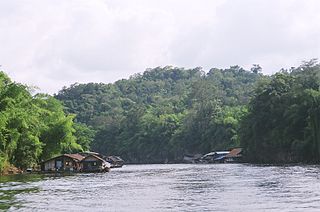
Sai Yok National Park is a national park in Sai Yok district, Kanchanaburi Province, Thailand. The park, home to mountains, waterfalls and caves, is part of the Western Forest Complex protected area.

Southern Line is a metre-gauge railway line in Thailand, operated by State Railway of Thailand (SRT), which runs through most of the provinces in the Central, Western, and Southern regions of Thailand. At 1,144.29 kilometres in length, it is Thailand's longest railway line.
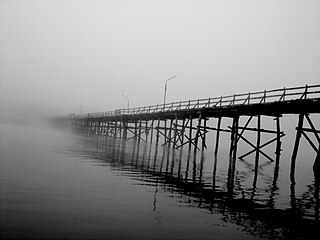
Uttamanusorn Bridge or commonly known as Mon Bridge and Wooden Mon Bridge (สะพานไม้มอญ) is a wooden footbridge in Tambon Nong Lu, Sangkhla Buri District, northwest of Kanchanaburi Province, Thailand. It spans the Songaria River.
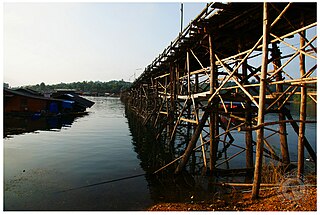
Songkalia River is a river in Kanchanaburi Province, Thailand. It combines with two other rivers, the Bikhli River and the Rantee River, at the confluence called Sam Sop or Sam Phrasop in Sangkhlaburi District to form the Khwae Noi River. "Song Ka Lia" in the Mon language means "over there".




















